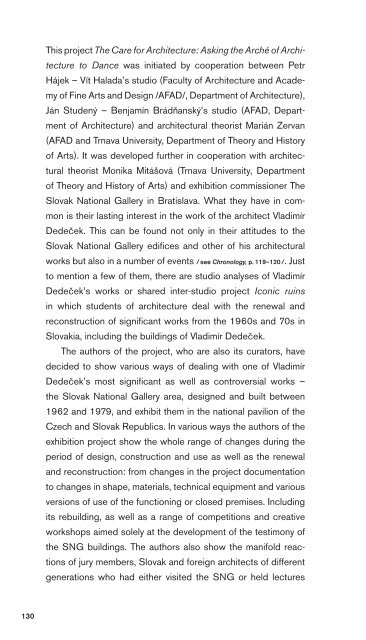sng_2016-05-12_high-single-crop_k3
Create successful ePaper yourself
Turn your PDF publications into a flip-book with our unique Google optimized e-Paper software.
This project The Care for Architecture: Asking the Arché of Archi -<br />
tecture to Dance was initiated by cooperation between Petr<br />
Hájek – Vít Halada’s studio (Faculty of Architecture and Academy<br />
of Fine Arts and Design /AFAD/, Department of Architecture),<br />
Ján Studený – Benjamín Brádňanský’s studio (AFAD, Department<br />
of Architecture) and architectural theorist Marián Zervan<br />
(AFAD and Trnava University, Department of Theory and History<br />
of Arts). It was developed further in cooperation with architectural<br />
theorist Monika Mitášová (Trnava University, Department<br />
of Theory and History of Arts) and exhibition commissioner The<br />
Slovak National Gallery in Bratislava. What they have in common<br />
is their lasting interest in the work of the architect Vladimír<br />
Dedeček. This can be found not only in their attitudes to the<br />
Slovak National Gallery edifices and other of his architectural<br />
works but also in a number of events / see Chronology, p. 119–<strong>12</strong>0 /. Just<br />
to mention a few of them, there are studio analyses of Vladimír<br />
Dedeček’s works or shared inter-studio project Iconic ruins<br />
in which students of architecture deal with the renewal and<br />
reconstruction of significant works from the 1960s and 70s in<br />
Slovakia, including the buildings of Vladimír Dedeček.<br />
The authors of the project, who are also its curators, have<br />
decided to show various ways of dealing with one of Vladimír<br />
Dedeček’s most significant as well as controversial works –<br />
the Slovak National Gallery area, designed and built between<br />
1962 and 1979, and exhibit them in the national pavilion of the<br />
Czech and Slovak Republics. In various ways the authors of the<br />
exhibition project show the whole range of changes during the<br />
period of design, construction and use as well as the renewal<br />
and reconstruction: from changes in the project documentation<br />
to changes in shape, materials, technical equipment and various<br />
versions of use of the functioning or closed premises. Including<br />
its rebuilding, as well as a range of competitions and creative<br />
workshops aimed solely at the development of the testimony of<br />
the SNG buildings. The authors also show the manifold reactions<br />
of jury members, Slovak and foreign architects of different<br />
generations who had either visited the SNG or held lectures<br />
130



